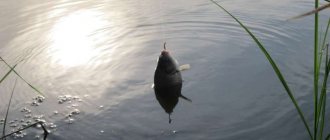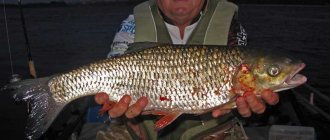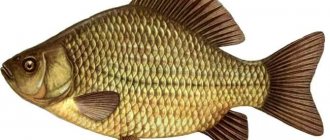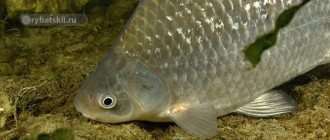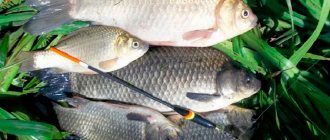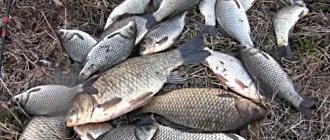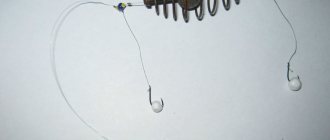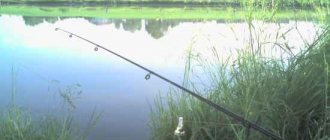Many fishing enthusiasts eventually become interested in catching large crucian carp. Crucian carp are considered large if they reach a weight of 1 kg or more; at times, fishermen manage to take trophies weighing 1.5-2 kg. He reaches this weight in 7-8 years, becoming more and more cautious. In this article we will deal with all aspects of such fishing, find out what to use to catch large crucian carp and tell you in detail about fishing tactics.
Where to fish
Crucian carp is found in most bodies of water, but large ones cannot be found everywhere. Typically these are large reservoirs with deep water areas.
There must be other white fish, which creates competition for food and a predator that regulates the number of small fish. All these factors contribute to increased nutrition and growth of fish.
Trying to catch big crucian carp on small lakes and ponds is almost pointless. There are plenty of small ones there, they will create certain problems when fishing, and large individuals are most likely in minimal quantities due to the lack of food supply.
Fishing on rivers is also not easy, although there are large crucian carp there. The fact is that numerous schools of roach, bream, and ruffe often turn out to be much more agile. But if such an abundance of fish is observed in a large closed reservoir, this can have a positive effect on fishing.
It makes no sense to catch trophy crucian carp where there are a lot of small fish - verkhovka, bleak, rotan.
Once on the pond, we decide on a place. Most often, the object of our fishing adheres to the following areas:
- Coastal areas with trees and bushes hanging over the water
- Small bays with lots of coastal vegetation
- Windows of clear water among the thickets
- Twisted places
- Sharp falls
- River turns
Large individuals are able to easily overcome strong currents, but try to avoid it. Therefore, on rivers, look for them in oxbow lakes and creeks.
Areas heavily overgrown with reeds will be attractive. You go there by boat, clear a place and cast. There will definitely be bites.
It happens that a large crucian carp moves from the depths closer to the surface. This is due to the fact that there is food at that level. If there is no food, the crucian carp changes position or goes back.
This explains his sometimes strange behavior - active biting one day and complete calm the next.
How to catch a large crucian carp among small ones
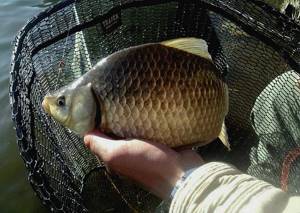
To catch trophy crucian carp in different conditions, you need to be able to “scare off” numerous small fish. Knowing the habits of fish will help you cut off small crucian carp for catching large ones in most cases.
Habits of large crucian carp
Unlike small and medium-sized crucian carp, large crucian carp have the following behavioral features:
- The main feeding time for large specimens is late at night. Early in the morning or late in the evening, medium and small crucian carp bite.
- Crucian carp weighing 1-2 kg leads a solitary lifestyle. Only occasionally does it gather in small flocks consisting of 2-3 specimens of equal size;
- Weighty crucian carp are much more careful and suspicious than their small counterparts. They take the bait less readily and impudently; they can often savor it for a long time, holding it in their mouth. From the outside it often looks like hesitant pecking at little things.
- Most of the time this fish leads a bottom lifestyle;
- Large crucian carp spawn later and longer than small and medium-sized fish;
- Unlike smaller individuals, large ones are less active and rarely leave deep holes.
How to cut off small fish
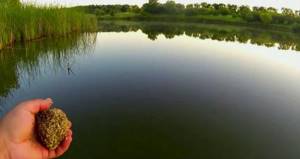
The essence of this operation is that the bait, which crumbles when it hits the water, attracts small crucian carp, leading it away from the main fishing area. In order to prevent small fish from biting when catching large specimens, you must:
- Feed the fish with dust-free baits that do not attract small fish;
- Heavily moisten the bait balls so that when they hit the water they quickly fall to the bottom and do not form a column of turbidity, which small fish quickly approach.
- Use large baits - worms, large balls of dough and porridge, a bunch of bloodworms.
Recommended reading: Perch in the wilderness
When to catch
The behavior of crucian carp, as well as its taste preferences, change depending on the time of year.
Spring
Crucian carp begins to be active in the spring, as the water warms up. It prefers areas where the water is warmer, often going to the mouths of small rivers and streams, where the depth does not exceed one meter. In deep reservoirs it tries to stay closer to the surface.
It can be caught throughout the day, the main thing is to check the weather forecast in advance. He is sensitive to any changes in weather conditions at this time. It is well caught before spawning, actively goes for mastyrku, medium-sized boilies.
Then, as the water warms up to 15 degrees, the bite stops and spawning begins. For a long time after spawning, large crucian carp do not feed. Resuming feeding, it becomes more picky about bait.
When the water begins to bloom and the oxygen level noticeably decreases, fish activity also declines.
Summer
Summer is considered one of the stable periods for fishing; crucian carp are now not so susceptible to weather changes. It usually feeds early in the morning and late evening, when the heat of the day subsides and the temperature drops. During particularly hot periods it can only be caught at night.
In some reservoirs with deep cold springs, it can be caught throughout the day. The main thing is to correctly determine the location of the keys.
It can be caught during the day if the weather is calm and windless and there is light rain. In heavy rains and bad weather, it stops catching, but before the onset of bad weather it actively feeds in reserve.
They catch more with plant baits; if there is no bite, they try animal baits.
Autumn
In autumn it is caught during the daytime, actively feeding before the approach of winter. The autumn feeding of crucian carp can continue until the first frost. As it gets colder, it moves to greater depths. During this period, it continues to feed near the pits.
In winter, it remains active in reservoirs with a hard, flat bottom, where there is no layer of silt, into which crucian carp usually buries itself for the winter.
How to Choose the Right Place to Fish for Crucian Carp?
In summer, Crucian carp tries not to appear in shallow water unnecessarily. It stands in the reeds, in deep (about 2 meters) holes. But “worth” does not mean “bites.” There he just rests.
It may pay attention to the bait, or it may ignore it. During those hours when it is not resting, the crucian carp slowly moves around the reservoir in search of food. Large crucian carp can easily overcome the current, but they don’t like it.
On rivers, there is a greater chance of finding this fish in bays and oxbow lakes, as well as in heavily overgrown areas of the reservoir with reeds at the border of open water and vegetation.
In early spring, large crucian carp can be caught on a weak current at the mouths of rivers flowing into a large body of water or in the straits between two bodies of water. The bait should be placed as close as possible to the border of aquatic vegetation and open water.
From Late May to Mid-September Large Crucian Carp Can Be Caught in the Following Places:
Snag;
A hole 1 to 2 meters deep with or without a weak, circular current;
Boundary between open water and aquatic vegetation.
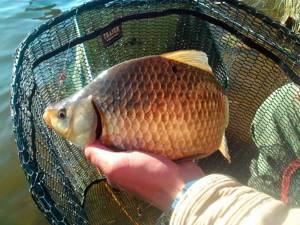
If all 3 Factors coincide, then this place will be ideal for catching large crucian carp in a reservoir with a current.
In calm water reservoirs in the summer, when catching large crucian carp, you will have to show miracles of patience and attentiveness.
In most reservoirs in summer, this fish stays away from the shore and appears near coastal vegetation only in the early morning and late evening. But this is not an axiom.
In deep, weakly warmed reservoirs, large crucian carp can come to the shore in the middle of the day. And in some shallow reservoirs of calm water, crucian carp begin to feed only after sunset and approach the shore only at dusk.
3 ways to improve your fish bite!

Over 15 years of active fishing, I have found many ways to improve the bite, and here are the most effective:
1. Bite activator . This pheromone additive attracts fish most strongly in cold and warm water. The Fish Hungry bite activator has proven itself to be excellent - Read more…
2. Tackle with increased sensitivity . You should first familiarize yourself with the features of using a particular type.
3. Pheromone baits . They attract the attention of fish, stimulate hunger and cause a schooling reflex, which allows you to collect a lot of fish in one place.
You can get the rest of the secrets of successful fishing for free by reading my other materials on the site.
3 ways to improve your fish bite!
Over 15 years of active fishing, I have found many ways to improve the bite, and here are the most effective:
1. Bite activator . This pheromone additive attracts fish most strongly in cold and warm water. The Fish Hungry bite activator has proven itself to be excellent - Read more…
2. Tackle with increased sensitivity . You should first familiarize yourself with the features of using a particular type.
3. Pheromone baits . They attract the attention of fish, stimulate hunger and cause a schooling reflex, which allows you to collect a lot of fish in one place.
You can get the rest of the secrets of successful fishing for free by reading my other materials on the site.
Fishing for crucian carp in autumn. Behavior of crucian carp before winter
In autumn, Large Crucian carp go to the depths, to places where the water still retains heat. At this time, you can catch it near wintering pits all day long. Each body of water has its own behavioral characteristics of large crucian carp.
In early spring, crucian carp can bite only in the middle of the day in all reservoirs.
Tackle
The selection of gear must be approached with special attention, since fishing for large crucian carp differs significantly from fishing for small and medium-sized fish. Therefore, we will analyze all types in detail. Large crucian carp are mainly caught with two types of gear - a float rod and a feeder.
Float tackle
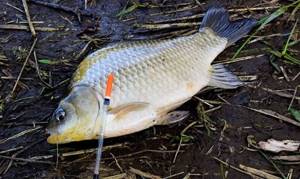
The most popular tackle, including for trophy fishing. The float rod equipment is as follows:
- A durable, lightweight rod 4-7 meters long, depending on the characteristics of the fishing location. If the length of the rod is over 5 meters, it is recommended to use carbon fiber tackle. A rigid tip is desirable, taking into account the casting distance and resistance of the fish.
- Spinning reel, size 3000-3500 according to Shimano classification
- Mono line, diameter 0.18-0.22 mm. In case of fishing in heavily overgrown areas, the use of braid with a diameter of 0.15-0.18 mm is justified.
- Sensitive float, weighing up to 3 grams, better with a long antenna
- Hook number 5-7 according to domestic markings
- Sinkers - depending on the load of the float. In addition, in calm weather, use a minimum load - you will see the most careful bite in time. In windy weather, the weights are placed so that one third of the float is on the surface
- Leashes - preferably made of fluorocarbon fishing line, with a diameter of 0.12-0.14 mm
Some fishermen prefer to do without weights. Instead, a triple swivel is tied to the main line, to the eyes of which leaders of different lengths are tied.
This type of equipment can be more effective - the equipment does not create resistance, the fish takes the bait more boldly. When fishing, the line will not twist or get tangled.
Feeder
Large crucian carp often stay far from the shore, so long casting is necessary, which can be achieved using feeder gear.
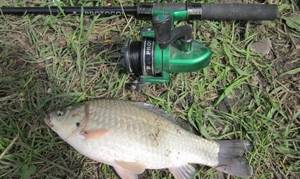
It consists of:
- Feeder rod, up to 3.3-3.5 meters long and weight up to 35-45 grams, for long casting – 3.5-4 meters and weight up to 50 grams.
- Reel, size 3500
- Mono line, diameter 0.2-0.25 mm, or braided line 0.16-0.2 mm
It is better to use float tackle when fishing at night, when large crucian carp come closer to the shore. The rest of the time, catching crucian carp on a feeder is more productive.
Makushatnik
A special type of tackle that uses cake. It is intended more for carp fishing, but professional fishermen successfully use it to catch trophy crucian carp. In this case, you need to follow two recommendations:
- Use crucian bait together with makukha
- Use as usual carp tackle, leaving the hooks free
For trophy fishing you will definitely need a landing net.
Assembling a float rod for crucian carp - fishing rod
Many people consider fishing for crucian carp too simple and even primitive. But this is far from true.
There are many nuances and features here. How successfully the tackle is assembled and the bait is chosen will ultimately determine the amount of catch.
So, how to catch crucian carp using the well-known float rod? If the reservoir is inhabited not only by small fish, but also by large individuals, you need to prepare thoroughly.
First we decide on the fishing rod. The most convenient and practical is telescopic.
The rod should be strong and its tip elastic. It is also taken into account that crucian carp places need to be looked for, and this means frequent transitions from place to place.
Therefore, choose a compact rod that is easy to assemble. Its weight is also important.
The lighter it is, the more convenient it is for the fisherman. In general, these are the main points to consider when choosing a fishing rod.
It only remains to add that its optimal length is 4–5 meters. But here everything is individual.
If you have to fish in hollows, near the shore, then it will be more convenient to take a three-meter rod.
To catch crucian carp in reservoirs, as a rule, float rods are used. Therefore, it is necessary to describe in more detail the options for their equipment.
If you need to decide how to catch crucian carp on a lake with shores overgrown with water lilies and calm water, then everything is quite simple. It is best to take a regular float rod with a fixed float.
The length of the rod will depend on how far the casts are. It can be from 3.5 to 7 meters.
The second equipment option involves the use of a sliding float. It slides freely along the line, but the depth must be adjusted with limiters. Most often these are rubber clamps that are installed slightly above the float. Well, the casting range is adjusted using a reel, unwinding the required length of fishing line. The main thing here is to be careful and avoid getting tangled.
And here's what you need to know: Spoons for pike perch in winter - fishing, rigging, working baits
Lures
Preparing gear and choosing a location are not all the main points. It is important to choose the right bait and bait.
A number of the main baits used to catch crucian carp are known to everyone. But what big crucian carp bite on remains a question for many. In principle, these are most of the same baits that small fish are caught with, but they also have their own characteristics.
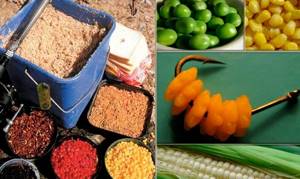
In spring and autumn these are animal baits - maggots, crawling worms, large bloodworms, grasshoppers. In summer, plant baits are preferable:
- Boiled potatoes
- Boyles
- Boiled pearl barley
- Steamed wheat
- Canned corn
- Semolina chatter
- Boiled pasta
Try to place the bait so that it completely hides the shank of the hook.
Due to its caution, big crucian carp often includes food that is familiar to it in its diet. In reservoirs with a small amount of aquatic vegetation, the main species are bloodworms and caddisflies. Where there is a lot of vegetation, it prefers young shoots and algae.
Features of catching crucian carp at different times of the year
Often, few fishermen catch really large crucian carp, since this is the type of fish that does not grow to a respectable size. But in order for the catch to be stable and very attractive, you need to take into account the seasons, since fish bite differently in different periods.
- Fishing for crucian carp in winter is considered the most difficult, since the bite in each body of water is unpredictable. Sometimes fishermen note that during the entire period of winter fishing they could not catch a single crucian carp. But winter fishing for crucian carp also has its advantages, since small specimens often hide from the cold in the depths, but large fish can swim much longer, so the chance of catching a truly worthy specimen increases significantly. The bite is best when the sun is shining brightly and there is practically no wind.
- Spring fishing for crucian carp is considered the easiest, because after wintering the fish are very hungry and eagerly rush to any bait. As soon as the water reaches a temperature of 8 degrees Celsius, the fish begins to show unprecedented activity, and when the temperature rises another 4 degrees, a really enviable bite will begin.
- Summer fishing for crucian carp is considered the most stable, since weather conditions and temperature conditions of the reservoir play the most minimal role here. At the beginning of June, you can’t count on a solid bite, because the fish begins to spawn, and after the crucian carp spawns, it needs several weeks to fully recuperate, so during this period it just lies on the bottom.
- Autumn fishing for crucian carp is quite difficult, because natural food begins to gradually disappear and the water temperature drops. At this time, the fish moves away from the shore to depths where it is warmer, so you will have to cast your gear as far as possible.
IMPORTANT! In autumn, the excellent bite begins when cloudy weather with drizzling rain lasts for several days. At this time, the fish’s appetite awakens and it needs to gain fat for wintering, so the chance of catching a large specimen increases significantly.
Lure
The use of bait is relevant both for feeder and float fishing for trophy crucian carp. Without bait, the chances of successful fishing are much less.
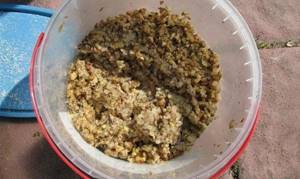
There are no universal complementary feeding options for large crucian carp, so fishermen have to fine-tune existing mixtures. It is believed that the best basis for crucian carp bait are porridges:
- Oatmeal
- Manna
- Corn
- Pearl barley
Breadcrumbs are added to give additional viscosity. In spring and autumn, it is recommended to add animal components to the bait.
In the summer, in addition to the plant components of the bait, fried and ground pumpkin seeds, sunflower seeds, and dill are added to the bait. Flavorings actively used:
- Anise
- Honey
- Vanillin
- Garlic
- Sugar
As an example, I will give a recipe for bait, with the expectation of attracting a solid trophy.
- Half a kilogram of pearl barley is washed, filled with water and placed on low heat.
- After 15-20 minutes, add boiling water to the pan and add 50 grams of millet and peas.
- Cook for another 10 minutes, stirring constantly
- Turn off the heat and let the bait sit for the remaining water to be absorbed.
- Allow the mixture to cool, add a little anise oil
- At the pond, the bait is rolled into balls and thrown to the fishing point.
Another simple option that does not require cooking:
- 5 grams sugar
- 2 grams of dill
- 80 grams each of bran, breadcrumbs and pumpkin seeds
This bait is mixed with clay and rolled into balls.
- Some baits may include:
- Finely chopped raw potatoes
- Steamed pearl barley
- Canned corn with anise
- Bran with ground cake with the addition of barley or pearl barley porridge
- Steamed wheat with cake
- Oatmeal or rolled oats, soaked in water
- Barley with cake and breadcrumbs
Some fishermen use store-bought baits, adding flavorings and natural ingredients to them:
- Cake
- Bran
- Rye crackers
- Ground sunflower seeds
It is recommended that the color of the bait match the color of the bottom of the pond, and the composition must contain bait components.
For one fishing trip you need no more than 3 kg of bait. Most of it is sent into the water immediately, the rest is thrown in during fishing, but only if the bite weakens significantly or stops completely. There is no need to make extra noise and scare the already cautious fish.
For more successful fishing, you can use bait. To do this, throw in a kilogram of complementary food every day 3-4 days before the start of fishing.
If it is not possible to deliver the bait to the intended point, try to accustom the crucian carp to the selected area. To do this, bait is prepared with a large amount of flavoring and sent to the selected area of the reservoir. The next day, the flavoring content in the bait decreases significantly. Closer to the beginning of fishing, we add a clean mixture without aromatic additives. The bait should consist exclusively of large particles.
Groundbait for Large Crucian Carp. The Most Important Ingredients
Unfortunately, there are no universal bait recipes suitable for catching large crucian carp. You can only modify the Standard bait for catching crucian carp and adapt it to the fishing conditions.
The bait will consist of the following ingredients:
The basis. The easiest way is to buy ready-made bait in the store;
Filler. You can use porridge, for example, millet or corn (mamalyga);
Baking powder. You can use molehill, soil from the shore of a reservoir, crushed crackers, sunflower cake, etc.
Flavoring. Fishing for crucian carp is most successful when using sunflower oil, anise, garlic - aromas of natural origin.
Small fish are always the first to flock to bait. Large crucian carp, unfortunately, think rather slowly. And he is always one of the last to arrive at the bait site.
Therefore, Large Ingredients need to be added to the bait:
Worm pieces;
Corn or Wheat Grains.

Branded Groundbait at Home. Issue 41. Video
Fishing tactics

This type of fishing has a number of features that should not be forgotten:
- Trophy crucian carp are very careful, so you need to maintain maximum silence and cast the tackle very carefully. You can even cast it further than the intended location, then slowly bring it where you need it.
- Clear the shore of everything unnecessary that could be a source of noise suspicious for fish - nothing should interfere with normal casting.
- The bite of a large one is different from the bite of a small one. The float sinks a little, after which it slowly moves towards the thickets.
- When there is a big fish on the hook, do not pull the tackle sharply upward. Let the fish remain in the water, the main thing is to keep the line taut and slowly reel in your prey.
- Take your time with fishing - if you feel strong resistance, loosen the brake, move closer to the surface
- In our case, it is important not only to pull out the hooked fish, but also not to scare away the others.
- Crucian carp, especially large ones, are picky, so take as many different baits as possible, combine them, alternate placement on the hook.
- If the bite suddenly stops, change the bait - the crucian carp has probably decided to switch to another one. Therefore, it is advisable to use several gears.
- Favorable hours for fishing are in the evening, starting from 19-20 hours until nightfall. At night they actively feed, on each reservoir at different times, which is determined experimentally by the fisherman himself.
- Good results are obtained by fishing from a boat, which allows you to find a hole or dump where large fish may be located.
Factors influencing biting
- Seasonality. Based on the monthly biting calendar, we can conclude that crucian carp is most active at the end of spring and throughout the summer season. Although crucian carp is a heat-loving fish, it does not like extreme heat. Therefore, in very hot weather in the summer, it refuses to peck. Thus, its activity directly depends on the water temperature, and the principle here is this: on warm days, the best catch will be in cool water, and, conversely, on cold days, in warm water.
- Atmosphere pressure. It bites best at low atmospheric pressure. Many beginners do not know this subtlety and often do not understand why everything seems to be fine, but there is no bite.
- The best time of day for fishing. The best bite should be expected early in the morning, about an hour and a half before dawn, and about an hour after dawn. During the day, the bite weakens, especially on hot summer days, but resumes in the evening, especially at dusk.
- Water temperature. It is caught at water temperatures from +8 to +30°C, but the most optimal temperature is +20-22°C. At temperatures below +8°C, crucian carp are caught extremely reluctantly, and at temperatures above +30°C, the fish tries to hide in depth and practically does not react to the bait.
- Place of catch. The optimal depth for a good bite is from 2 to 4 m. Shallow water, places where water lilies and lilies grow, as well as overgrown with reeds, near fallen trees.
Features of behavior
- Large crucian carp usually live alone or in small schools of 3-4 individuals
- Often located closer to the bottom
- Less active and mobile in contrast to small ones, remains in its favorite place for a long time
- The larger the food supply in the reservoir, the smaller the area of its movement
- Tests the nozzle for a long time before grabbing it
- Feeling the slightest resistance, he will immediately throw the bait
- Spawning starts later and takes longer
- In winter it may not hibernate and continue to be caught
Plant attachments
Any crucian carp is, first of all, an inhabitant of the reservoir. The diet of this fish depends on what crucian carp can find in the reservoir.
In most reservoirs, large crucian carp are conservative. The main baits for catching this fish in early spring are bloodworms, maggots, small worms, and shitik;
Before spawning, in the diet of large crucian carp, protein dough, mastyrka, and small boilies are added to baits of animal origin. After spawning, large crucian carp become a gourmet. The nozzle needs to be selected. But even after picking it up, you can’t be sure that the fish will bite on it the next day.
In summer, it is customary to use bait of plant origin to catch large crucian carp: pearl barley, wheat, canned corn, and small boilies. But, if there is no bite, you should try baits of animal origin.
The red worm is considered a universal bait for crucian carp, suitable in all seasons. You can put a worm on a hook and add pearl barley to it. Sometimes it helps.
If during fishing the bites subside and the crucian carp disappears, then you need to get your bearings in time and change the bait. Let's consider what else can be offered on the hook to this fish.
In addition to animal bait, the fisherman should also have vegetable bait with him. Crucian carp are best caught using semolina, steamed pearl barley and pea mash.
There are cases when crucian carp also takes corn. But this bait is more likely for carp.
And here's what you need to know: Catching pike with a bottle from the shore
So, how to catch a crucian fish when it starts to “be capricious”? Once again, it is worth recalling the basic rule: the more attachments, the greater the chances of success. We put an attractive bunch of worms on one fishing rod, and start experimenting on the second.
First, it is recommended to make a sandwich, for example, put a worm and pearl barley on a hook. If there is no bite, we take a mastyrka or chatterbox.
The crucian carp will definitely bite on something. In any case, if there is a lull, then you need to change the bait.
If small things are constantly biting
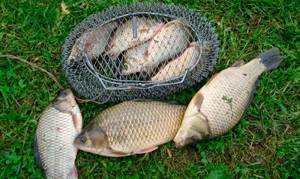
It happens that there is a huge amount of small fish in a reservoir and after feeding, they gather in huge quantities, leaving large fish aside. Therefore, sooner or later, every angler asks the question - how to catch large crucian carp among small ones. There are several ways.
- We feed several areas. We throw a larger amount of bait into one of them, concentrating it in a small area. To the side we feed another area with a minimum amount of mixture. If you added bait to the bait, keep in mind that the second bait should contain only large components of the bait.
- Thus, it is possible to distract small crucian carp with a large amount of food. The big one will go where there is less food, but there is less competition. This tactic works with both a float rod and a feeder.
- Change the bait. It has been noticed that small crucian carp less often take pearl barley, wheat, corn, corn, and boiled potatoes. Especially if it is a large-sized bait and several pieces are attached to the hook.
- You can distract the little ones by using dusty bait of lower viscosity with a large amount of flavorings. This will alert large fish, but small ones will probably be interested.
- Fish at night, when the small fish practically do not feed.
Fishing in summer
In summer, crucian carp are active only in the morning and evening. The fish cannot stand the hot sun and go in flocks into deep holes. As soon as the shadows from the trees begin to fall and evening approaches, the crucian carp swims out of the holes and begins to look for food. In summer, fish are more willing to take vegetable baits (peas, corn, various cereals). The best bait can be ground roasted sunflower seeds.
In summer, both bottom and float gear are used to catch crucian carp. Do not forget that this fish is capricious.
Her preferences change several times a day. You should take a great variety of bait with you.
Fishing line, hooks, leashes are selected for certain conditions. If there is carp in the pond, then the fishing line needs to be thicker.
If only small palm-sized crucian carp live in the water, then a thin fishing line is best. Thanks to it, the catch will increase, because the fish are shy.
The influence of the bottom when fishing for crucian carp
The crucian carp gets its food by digging at the bottom, which raises a cloud of turbidity. Experienced fishermen can find a crucian carp trail by the abundance of bubbles that float to the surface.
This means that at the moment a school of crucian carp is digging in the ground, tearing it apart in search of something nutritious. Well, in the summer, on especially hot days, fish can bury themselves shallowly in the mud to cool down at least a little.
The crucian carp spends the winter there, but it is found somewhat deeper.
But sometimes this species can be found on hard ground. Here you can think about how to catch crucian carp on a donk.
Small living organisms live in large numbers on the hard bottom, so fish must be attracted to the fishing site. This is why a feeder with bait mixture is needed.
But first you need to find out what the nature of the soil is in this area of the reservoir. To do this, attach a sinker weighing 30 grams to the fishing line and cast.
We wait until it drops and begin to slowly drag it to the shore. If there is practically no resistance, then the bottom is muddy.
If the line moves with effort, then the sinker probably got into the clay. In areas with a sandy or rocky bottom, crucian carp is practically not found.
It is useless to catch him in such places.
So, how to catch crucian carp in a pond with a muddy bottom? The main thing is to understand that, most likely, the bait with the bait will go several centimeters into the silt with a sinker. Of course, the crucian carp will be able to find it if it fumbles around in search of food, but it is best to give the bait buoyancy, for example, by putting a foam ball on the hook.
If a feeder is used, then it must also be equipped with special foam strips. It is also worth abandoning metal models.
Silicone feeders are best.
